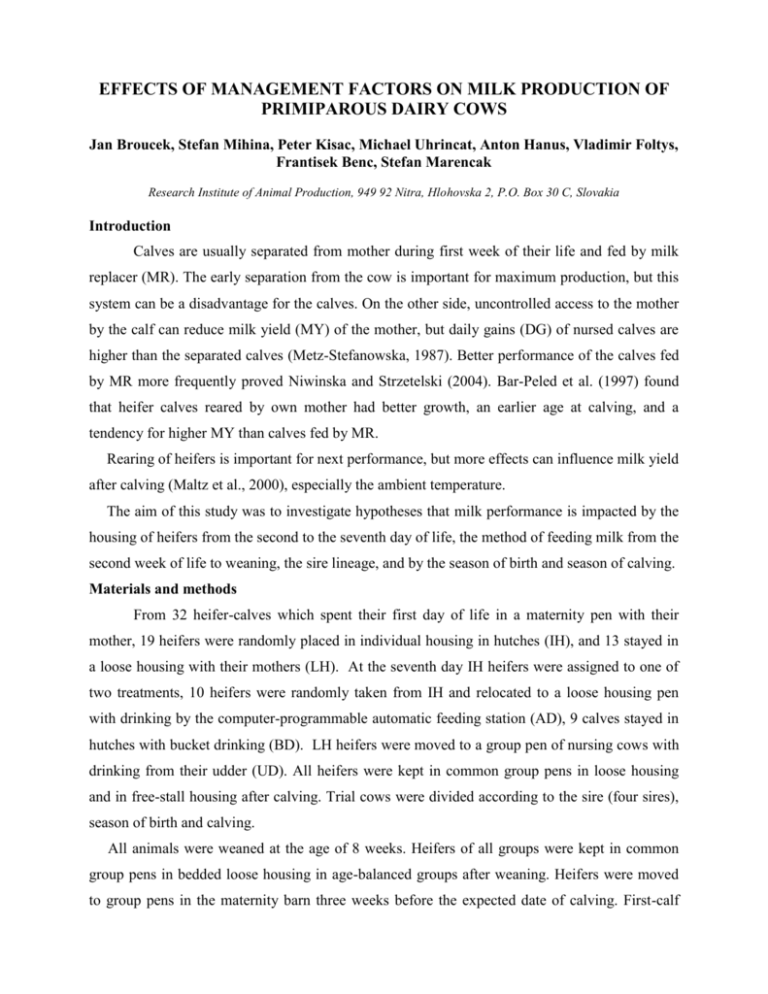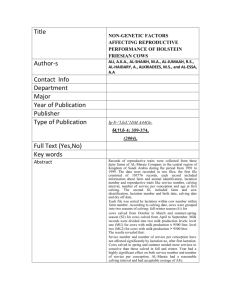Effects of Management Factors on Milk Production in First
advertisement

EFFECTS OF MANAGEMENT FACTORS ON MILK PRODUCTION OF PRIMIPAROUS DAIRY COWS Jan Broucek, Stefan Mihina, Peter Kisac, Michael Uhrincat, Anton Hanus, Vladimir Foltys, Frantisek Benc, Stefan Marencak Research Institute of Animal Production, 949 92 Nitra, Hlohovska 2, P.O. Box 30 C, Slovakia Introduction Calves are usually separated from mother during first week of their life and fed by milk replacer (MR). The early separation from the cow is important for maximum production, but this system can be a disadvantage for the calves. On the other side, uncontrolled access to the mother by the calf can reduce milk yield (MY) of the mother, but daily gains (DG) of nursed calves are higher than the separated calves (Metz-Stefanowska, 1987). Better performance of the calves fed by MR more frequently proved Niwinska and Strzetelski (2004). Bar-Peled et al. (1997) found that heifer calves reared by own mother had better growth, an earlier age at calving, and a tendency for higher MY than calves fed by MR. Rearing of heifers is important for next performance, but more effects can influence milk yield after calving (Maltz et al., 2000), especially the ambient temperature. The aim of this study was to investigate hypotheses that milk performance is impacted by the housing of heifers from the second to the seventh day of life, the method of feeding milk from the second week of life to weaning, the sire lineage, and by the season of birth and season of calving. Materials and methods From 32 heifer-calves which spent their first day of life in a maternity pen with their mother, 19 heifers were randomly placed in individual housing in hutches (IH), and 13 stayed in a loose housing with their mothers (LH). At the seventh day IH heifers were assigned to one of two treatments, 10 heifers were randomly taken from IH and relocated to a loose housing pen with drinking by the computer-programmable automatic feeding station (AD), 9 calves stayed in hutches with bucket drinking (BD). LH heifers were moved to a group pen of nursing cows with drinking from their udder (UD). All heifers were kept in common group pens in loose housing and in free-stall housing after calving. Trial cows were divided according to the sire (four sires), season of birth and calving. All animals were weaned at the age of 8 weeks. Heifers of all groups were kept in common group pens in bedded loose housing in age-balanced groups after weaning. Heifers were moved to group pens in the maternity barn three weeks before the expected date of calving. First-calf dairy cows were kept in pens with free-stall housing and fed according to stage of lactation. All calves sucked colostrum free choice from their mother during the first 24 hours. AD and BD calves received colostrum and mothers milk free choice three times a day from a nipple bucket from the second to seventh day. UD calves were allowed to suck their dams ad libitum. AD and BD calves were drank from the eighth day by a MR. They were given 6 kg MR per day divided into 4 (AD) or 2 (BD) portions. UD animals were moved to a nursing cow pen on the eighth day. The number of calves per one nursing cow was determined according to the milk yield (6 kg milk per each calf). From the second day until weaning the calves could eat starter mixtures and alfalfa hay free choice. From the age of 90 days they also got corn silage. All heifers were fed the same diet. During the lactation, the total mixed ration was balanced according to nutrient requirements of dairy cattle and included the factors and equations adopted for maintenance, growth, reproduction and lactation. Milking occurred twice daily with a milking interval of 12 hours in a 2x5 stall herringbone parlor, and individual milk yields were recorded once weekly. Proportional milk samples were collected fortnightly. The data were analyzed with a statistical package STATISTIX. The normal distribution of data was evaluated by Wilk-Shapiro/Rankin Plot procedure. Data consisting of MY and milk composition conformed to a normal distribution. Among-group comparisons were analysed using a General linear model ANOVA. Significant differences among means were tested by Bonferroni´s test. Results The production of milk, FCM and protein were higher in the LH group than in the IH group (6894.1kg vs. 6202.1 kg; P<0.01; 6541.9 kg vs. 5986,4 kg, P<0.05; 215.3 kg vs. 193.2 kg; P<0.05). UD group displayed the highest production of milk (6894.1 kg) and animals AD group the lowest (5757.5 kg; P<0.01). A similar trend was recorded also in the case of FCM. The content of fat was highest in the AD group (4.10%) and lowest in the BD group (3.57%; P<0.05). UD cows produced more protein than AD (215.3 kg vs. 180.9 kg, P<0.01). Dairy cows AD produced the least lactose and SNF. Sire effects were different for fat percentage (P<0.001), lactose yield and total solids (TS) (P<0.01), for milk yield, protein and lactose percentage, as well as non-fat solids (NFS) yield and content (P<0.05). Dairy cows born in winter had the highest production of milk, protein, lactose, NFS and TS and dairy cows born in the summer the lowest (6882.5 kg vs. 5639.7 kg; P<0.05; 215.6 kg vs. 173.5 kg, P<0.01; 347.9 kg vs. 277.9 kg, P<0.05; 617.1 kg vs. 499.9 kg and 849.5 kg vs. 720.4 kg; P<0.05). FCM and fat yields were highest in the group born in the fall and lowest in the group born in the summer (6668.1 kg vs. 5563.5 kg; P<0.05; 270.2 kg vs. 220.5 kg (P<0.05). Dairy cows calved in the winter and in the spring yielded the most (6942.5 kg and 6924.9 kg, respectively), while dairy cows calved in the summer yielded the least (5764.4 kg). Cows calving in the winter produced the most protein (218.9 kg) and cows calving in the summer the least (178.7 kg). The productions of lactose and NFS were also different. Discussion The significantly higher production performance of UD cows can likely be explained by a higher live weight at calving compared to AD and BD groups, which was the result of better growth during rearing. This could be probably as a result of a higher intake of milk even though the amount of milk obtained was limited. The nutrient quality of whole nursed milk likely exceeded that of the MR. Animals UD obviously received more valuable liquid nutrients directly from the udder than groups AD and BD (Bar-Peled et al., 1997). Ad libitum feeding from nurse cows could reduce the incidence of diarrhea compared to feeding MR. The lower growth of AD calves would be also a result of their poorer health due to rearing environment. A common nipple suckled by calves in a group could be a method of spreading disease (Svensson et al., 2000). Dairy cows born in the winter showed the highest production of milk, protein, lactose, SNF and TS. There is probably a close relationship with growth rate. Calves born in winter tended toward higher DG than did calves born in other seasons (Place et al., 1998). The effect of birth season on production may be attributed to changes in either temperature or photoperiod (Barash et al., 2001). Therefore the duration of the photoperiod or temperature would most likely affect future milk production. It is possible that dairy cows calved in the period from December to February would reach a higher average production during lactation, particularly due to an effect of a higher persistency of the lactation curve. The most favorable persistency of the lactation curve is in dairy cows calving in January and February, i.e. during a subsequent prolongation of daylight. It seems that low winter temperatures enable a cow in the first third of lactation to express her full milk yield potential. Contrary, high temperatures during summer cause stress in dairy cows. High temperatures have not only a direct but also a latent effect during a dry period (Moore et al., 1992). The reason for this may be decreased immunity and transfer of maternal immunoglobulins to colostrums in mothers, vigor and ability of the calf to absorb immunoglobulins of newborns during hot weather. Conclusions Results of this study indicated that management factors during rearing of calves are very important after first calving. Milk production of first-calf heifers is impacted by the manner of drinking during milk-feeding period, their sire lineage, and by the season of birth and calving. The highest milk yields were recorded in heifers which were raised until weaning by nursing cows and the lowest in heifers fed by automatic feeding station. The rearing of newborn heifers by nursing cows may create advantages for later production. Milk efficiency was the highest in cows born and calving in the winter and the lowest in cows born and calving in the summer. It may be wise to decrease the number of heifers and cows calving during summer by regulating breeding. References 1. 2. 3. 4. 5. 6. 7. 8. Barash, H., N. Silanikove, A. Shamay, and E. Ezra. 2001. Interrelationships among ambient temperature, day length, and milk yield in dairy cows under a mediterranean climate. J. Dairy Sci. 84:2314-2320. Bar-Peled U., Robinzon B., Maltz E., Tagari H., Folman Y., Bruckental I., Voet H., Gacitua H., Lehrer A.R., 1997. Increased weight gain and effects on production parameters of Holstein heifer calves that were allowed to suckle from birth to six weeks of age. J. Dairy Sci. 80, 2523-2528. Maltz E., Kroll O., Barash H., Shamy A., Silanikove N., 2000. Lactation and body weight of dairy cows: interrelationships among heat stress, calving season and milk yield. J. Anim. Feed Sci. 9, 33 – 45. Metz-Stefanowska J., 1987. Productivity aspects of keeping dairy cow and calf together in the post-partum period. Livest. Prod. Sci. 16, 385-394. Moore, R. B., J. W. Fuquay, and W. J. Drapala. 1992. Effects of late gestation heat stress on postpartum milk production and reproduction in dairy cattle. J. Dairy Sci. 75:1877-1882. Niwiňska B., Strzetelski J.A., 2004. Effects of type of liquid feed and feeding frequency on calf performance. J. Anim. Feed Sci. 13, Suppl. 1, 167- 170. Place N. T., Heinrichs A.J., Erb H.N., 1998. The effects of disease, management, and nutrition on average daily gain of dairy heifers from birth to four months. J. Dairy Sci. 81, 1004–1009. Svensson C., Emanuelson U., Petterson K., 2000. Health status of dairy calves kept in individual pens or in group pens with or without automatic milk feeder. In: Proceedings of Xth International Congress on Animal Hygiene. Maastricht (The Netherlands), Editor: M.J.M.Tielen and M.Th.Voets, pp. 426-430.



